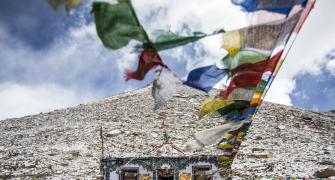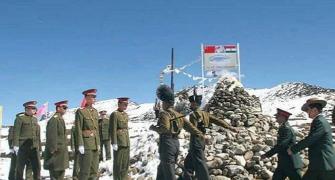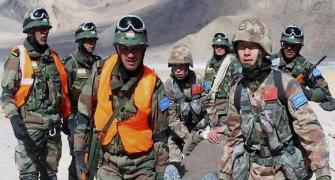We should have anticipated it on August 5 last year, when we made the big changes in J&K.
Amit Shah left nothing to chance when he told Parliament that 'we will bring back Aksai Chin even at the cost of our lives'.
'Then, there were the new maps, objections to the CPEC going through Indian territory, the weather reports.'
A broad territorial status quo had existed in Ladakh-Aksai Chin since 1962.
India made its intention to change this public, notes Shekhar Gupta.

Why, when the Chinese PLA comes bullying its way along the borders in Ladakh am I invoking an outrageous American political satirist, P J O'Rourke?
Among his finest pieces is his A Brief History of Man.
You can find it in his collection Republican Party Reptile. In less than a thousand brilliant words it spans the entire human history.
He takes all the great civilisations and reigns that rose and fell or survived in that sweep.
What's relevant to us today is one short sentence in which he dismissed China: 'Meanwhile, in China, there were the Chinese.'
You can interpret that any way you wish.
My guess is that he's conveying that sense of resignation you find about the 'inscrutable' Chinese.
A familiar thought in the West.
But we don't live in the West.
We've lived next door to China for as long as first civilisations grew.
If we study our own post-Independence interactions with the Chinese, what is it that we might describe as inscrutable? Their military assault across two fronts in 1962 may have been a surprise to our leaders, but that is only because they were delusional.

Every Chinese action with respect to India -- since their ultimatum to India to 'return their stolen yaks and sheep' in 1965, when the 22-day war with Pakistan raged, to their supposedly "surprise" appearance along the Ladakh frontier this year -- in fact, shows that the Chinese are far from inscrutable.
They are predictable.
The push at Nathu La (Sikkim) in 1967 was probably to check out the resolve from India.
That they saw at its weakest, having fought two recent wars (1962 and 1965), famines, ship-to-mouth existence, political instability, and a diminished Indira Gandhi.
Remember, they had already joined the nuclear club in 1964.
The Indian response was a lesson they quickly learnt.
A lot of detail on that short, sharp, local but historic engagement has recently been published in a full-length book Watershed 1967: India's Forgotten Victory over China by Probal Das Gupta, which I was honoured to write a blurb for.
What did the Chinese do after that? They have kept the peace for 53 years.
Will you call that response evidence of Chinese inscrutability?
They probed us, got a rude pushback, and decided to wait and stir the pot in different ways, at different times.
Over six decades since about 1960, the Chinese have been able to dictate the evolution of their ties with India, with the pace and landmarks of their choosing.
Whatever blunders we might fashionably blame Nehru for today, he ceased to matter in 1962.
The Chinese retained what they really wanted in 1962.
The truth is, they had it in their possession almost fully, barring small, tactically important slivers in Ladakh.
They asserted their ownership and let their larger claim, Arunachal Pradesh, fully in Indian control, go militarily uncontested.
They never gave up their claim on it.
Their view rose and ebbed as power equations evolved, in the region and the world.
They checked us out again in 1986-1987 at Wangdung-Sumdorong Chu (Arunachal), when they saw Rajiv Gandhi take India's defence budget to a never-before-or-after 4 per cent-plus of GDP, especially when the India-Pakistan situation was on the edge during Exercise Brasstacks.
Once again, the response (General Sundarji's Exercise Chequerboard) was firm and the Chinese backed off.
Lesson again, the Chinese won't open fire for the heck of it.
Or when they are absolutely sure of an easy victory so they could be seen like 'teaching an upstart a lesson' as they did in 1962. Predictable.
So much else, Mao Zedong reportedly flashing that enigmatic Mona Lisa smile at a young Brajesh Mishra, then heading the Indian embassy in Beijing as a mere charge'd affaires in 1970, to a nuclear test to the embarrassment of Atal Bihari Vajpayee visiting Beijing as the Janata Party's foreign minister, sabre-rattling over Dalai Lama's visits to Tawang, all fit that pattern.
Everything, from 1962 to Doklam, fits a pattern: Deliver a message, add leverage, and return.

All the stand-offs after that, including recent ones such as Chumar, Depsang Plains, and Doklam, have ended the same way.
The message is, see, who's the boss out here.
In Chumar, it was to India as it was feting Xi Jinping.
In Doklam, to Bhutan.
Whatever our pretence, we journalists are not experts at most things.
Least of all on China.
But journalists also have the privilege of learning from people who know better.
We have learnt over the decades from our finest minds over two generations, from the late K Subrahmanyam, the greatest strategic scholar of independent India, and General Krishnaswamy Sundarji to C Raja Mohan now, and many others.
But two conversations stand out in today's context.
Manmohan Singh, as prime minister, met a group of editors and gave us a masterful tutorial.
He said China was coolly using Pakistan as an instrument to keep India perpetually off-balance.
Our future, therefore, lay in breaking out of this 'triangulation'.
His choice, obviously, was to reach out and seek peace with Pakistan.
A much bigger and powerful China, he thought, would see less of an incentive for peace with India than Pakistan.
In any case, for China, it is a low-cost strategy to keep India pre-occupied with its client-State Pakistan.
That was his idea of breaking out of this triangulation.
Today, that option is not so available as hostility with Pakistan is central to the Modi-BJP politics.
They'd rather make peace with China than Pakistan.
That is why the lavish welcomes and frequent meetings with the Chinese leaders.
The objective, still, is escaping that triangle.
The second was Vajpayee explaining the Chinese negotiating style.
'Dekhiye, aap aur hum baithe hain aur vaarta kar rahe hain (see, you and I are sitting and negotiating),' he said.
Both of us want something.
I will ask you, let go of a little, you will say no. I'd say ok, a little less then. You will again say no. But ultimately you will relent and let go of some. The Chinese would never do that.
Both these leaders underlined the same point -- that the Chinese are consistent and predictable.
That is why we should not be surprised by what they have unveiled across Ladakh.
We should have anticipated it on August 5 last year, when we made the big changes in Jammu & Kashmir.

We were not oblivious of the fact that there is indeed a third party in the territorial jumble there and that is China.
Union Home Minister Amit Shah left nothing to chance when he said in Parliament that 'we will bring back Aksai Chin even at the cost of our lives'.
Then, there were the new maps, objections to the China-Pakistan Economic Corridor going through Indian territory, the weather reports.
A broad territorial status quo had existed in Ladakh-Aksai Chin since 1962. India made its intention to change this public.
Don't ask me what is exactly happening on the ground in Ladakh.
Are the Chinese on this side of the LAC or that? Because I don't know.
I can't read satellite pictures.
How others read them depends on which side of the political divide they are on.
At a time so polarised that even a 65-year-old, half-cent per pill drug like HCQ becomes politicised, you hardly expect much honesty being extended to satellite images of barren, naked mountains.
What I can say is, this should have been anticipated and gamed before the die was cast on August 5 last year.
This Chinese move, like all others in 60 years, was fully predictable.
Even the timing. It was only a matter of the snows melting.
By Special Arrangement with The Print
Production: Aslam Hunani/Rediff.com










